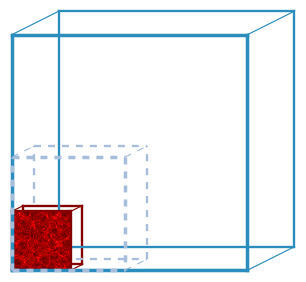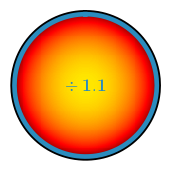Data Guide | GiggleZ-MR
This simulation is good for ...
- Modelling galaxies with stellar mass above ~10^8.5 Msun
- Galaxy evolution studies with volume-limited low-redshift surveys
Overview
The GiggleZ-MR simulation is one of many in the Gigaparsec WiggleZ cosmological N-body simulation suite (Poole et al. 2015), which were performed with GADGET2. This "Medium Resolution" run is currently the only one of the suite available on TAO. GiggleZ-MR offers a similar mass resolution to Millennium but has more up-to-date cosmology and a more in-depth construction of merger trees.
Relative size
- Box length: 125 h^-1 Mpc
The volume relative to Millennium and an all-sky survey out to z=0.05:

Mass resolution
- Particle mass: 9.5 × 10^8 h^-1 Msun
- Gravitational softening: 4.6 h^-1 kpc
- Number of particles: 520^3
- Number of snapshots to z=0: 59
The particle size compared to Millennium:

GiggleZ-MR has 1.1 times lower mass resolution than Millennium, meaning a Millennium halo contains 1.1 times the number of particles of a GiggleZ-MR halo of equivalent mass.
Cosmology
The cosmological parameters of the GiggleZ simulations are based on WMAP-5 data, in addition to supernovae and baryonic acoustic oscillations (Komatsu et al. 2009).
- Ω_M = 0.273
- Ω_Λ = 0.727
- Ω_b = 0.0456
- σ_8 = 0.812
- n = 0.96
- h = 0.705
Haloes
Haloes and subhaloes were identified using the popular SUBFIND code. The merger trees of these haloes were built according to the method to be presented in Poole et al. This approach repairs pathological defects in merger trees introduced by the halo-finding process (e.g., over linking, or the disappearance of halos during pericentric passages) through a process of forward and backward matching which scans both ways over multiple snapshots.